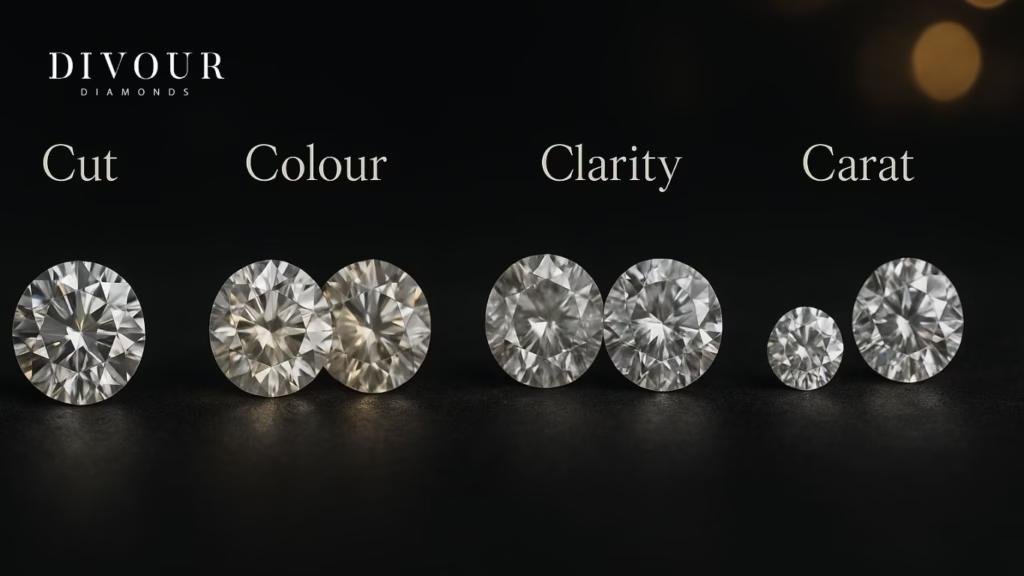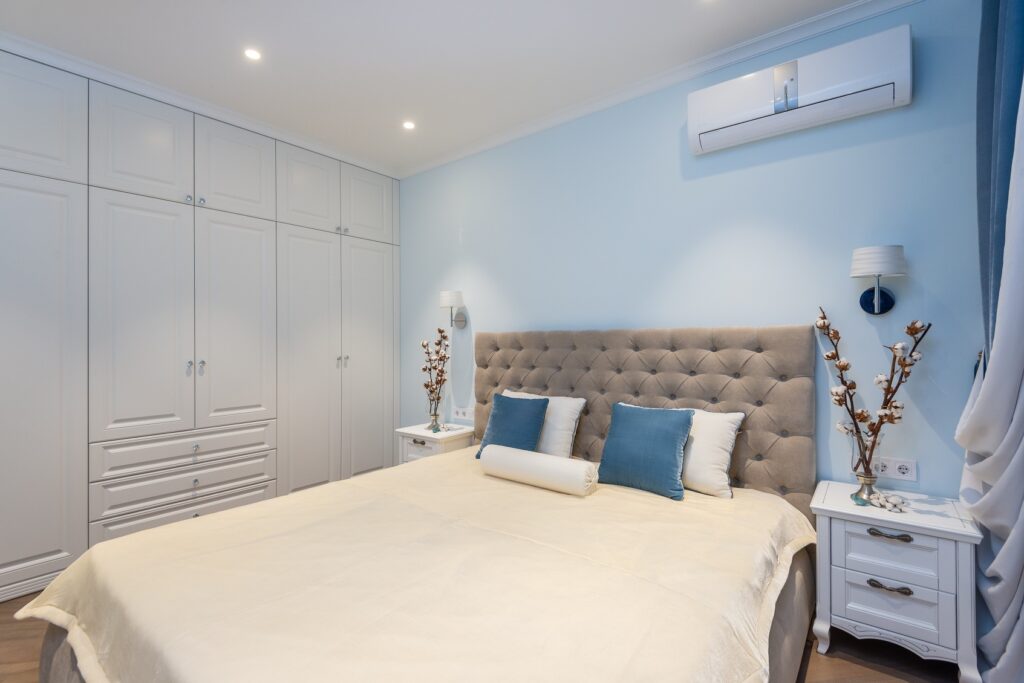Shopping for a diamond can feel overwhelming. Whether you’re choosing an engagement ring in London’s historic Hatton Garden or browsing online for the perfect anniversary gift, you’ve probably heard about the “4Cs.” But what do they actually mean, and why should you care?
Don’t worry; we’ll explain it all in simple terms. By the end of this guide, you’ll know exactly what to look for when buying a diamond in the UK, and how to get the best value for your money.
What are the 4Cs that make up diamonds?
The 4Cs are the most widely used way to judge the quality of a diamond. The Gemological Institute of America (GIA) made them, and they are used all over the world, even here in the UK. They stand for:
- Cut: How well the diamond is shaped and how well the facets are cut.
- Colour: The absence of colour in the diamond
- Clarity: Whether or not there are flaws inside the object
- Carat: the size and weight of the diamond
Think of the 4Cs as your diamond’s report card. Each one affects how the stone looks, how it sparkles, and ultimately, how much it costs. Let’s explore each one.
Cut: The Most Important C
Here’s something many people don’t realize: cut is the only C that’s entirely human-made. Nature decides the colour, clarity, and carat weight, but skilled craftspeople decide the cut.
What does “Diamond Cut” mean?
Cut refers to how well a diamond’s facets interact with light. It’s not about the shape (round, princess, oval) – it’s about the proportions, symmetry, and polish.
A well-cut diamond will:
- Sparkle brilliantly (that’s called “brilliance”)
- Display flashes of colour (called “fire”)
- Look bright and shiny, which is called “scintillation.”
A poorly cut diamond, even with perfect colour and clarity, will look dull and lifeless.
- Cut Grades: Diamonds are rated on their cut from Excellent to Poor:
- Excellent/Ideal: The most sparkle and fire
- Very Good: Excellent sparkle at a better price point
- Good: Nice sparkle, more affordable
- Fair/Poor: Noticeably less brilliant
Our Advice for UK Buyers
For engagement rings and special pieces, stick with Excellent or Very Good cuts. The difference in sparkle is dramatic, and it’s the first thing people notice. You can give in on other Cs, but not on cut.
Tip: Because lab-grown diamonds are made in controlled environments, they often have better cut quality at the same price as natural diamonds.
Colour: The Subtle Difference
When we talk about diamond colour, we’re actually talking about the lack of colour. The most valuable diamonds are completely colourless, allowing light to pass through and create maximum sparkle.
The Colour Scale Diamonds are graded from D (colourless) to Z (light yellow or brown):
- D-F (Colourless): Pure white, no colour visible to the naked eye
- G-J (Near Colourless): Excellent value; colour only detectable when compared to higher grades.
- K-M (Faint Colour): There is a hint of warmth, especially in bigger stones.
- N-Z (Light Colour): A yellow or brown tint that is easy to see
What You’ll Really See
Here’s the honest truth: most people can’t tell the difference between a D and a G colour diamond when it’s set in a ring. There is a very small difference.
What We Think UK Buyers Should Do
We suggest G-H colour for white gold or platinum settings, which are popular in the UK. You’ll save money without sacrificing beauty. For yellow or rose gold, you can go down to I-J, as the warm metal actually complements a slight warmth in the diamond.
Tip for saving money: A diamond with a H colour and a good cut will look better than a diamond with a D colour and a good cut, and it will cost less.
Clarity: What’s Hiding Inside?
Clarity refers to tiny imperfections in or on the diamond. Internal flaws are called “inclusions,” and surface flaws are called “blemishes.”
Here’s the good news: most clarity characteristics are microscopic. You need a jeweler’s loupe (10x magnification) to see them.
Clarity Grades
From best to lowest:
- FL (Flawless): No inclusions or blemishes visible at 10x magnification
- IF (Internally Flawless): No inclusions, only minor surface blemishes
- VVS1-VVS2 (Very Very Slightly Included): Inclusions that are hard for experts to see
- VS1-VS2 (Very Slightly Included): Minor inclusions, not visible to naked eye
- SI1-SI2 (Slightly Included): Noticeable under magnification, sometimes visible to naked eye
- I1-I3 (Included): Obvious inclusions that affect transparency and brilliance
What “Eye-Clean” Means
This is the magic term you need to know. An “eye-clean” diamond has no inclusions visible to the naked eye. Many VS2 and SI1 diamonds are eye-clean, which means you can get a beautiful diamond without paying for flaws you can’t see.
Our Advice for UK Buyers
For diamonds that are less than 1 carat, VS2-SI1 is the best balance of quality and price. If you have a diamond that is 1.5 carats or more, you might want to look for a VS1 or higher because inclusions are easier to see in bigger diamonds.
Money-saving insight: Lab-grown diamonds typically have fewer inclusions than natural diamonds at the same price, making them an excellent choice for clarity-conscious buyers.
Carat: Size Matters (But Not the Way You Think)
Carat is simply a unit of weight. One carat is the same as 200 milligrammes, or 0.2 grammes.
Size vs. Carat Weight
This is what confuses people: carat measures weight, not size. Two diamonds of the same carat weight can look different sizes depending on their cut proportions.
Popular Sizes in the UK UK preferences tend toward elegant, timeless sizes:
- 0.5 carat: Fine and delicate, great for little fingers
- 0.75-1.0 carat: The UK’s most popular engagement ring size
- 1.5 to 2.0 carats: pieces that make a statement without being too flashy
- 2.0+ carat: Show stopping luxury.
Price Jumps at “Magic Numbers”
Here’s a secret from the inside: diamond prices go up a lot at certain weights, like 0.5, 0.75, 1.0, 1.5, and 2.0 carats.
A 0.95-carat diamond can cost 15-20% less than a 1.0-carat diamond, yet they look virtually identical when worn.
Our Advice for UK Buyers
If money is tight, go a little below the magic numbers. A 0.95-carat diamond gives you nearly the same visual impact as a 1-carat for significantly less money.
Smart shopping: When buying things, British people often care more about quality than size. A smaller diamond with an Excellent cut will always look better than a bigger diamond with a Fair cut.
How the 4Cs Work Together
The secret to diamond buying isn’t maximizing all four Cs – that’s prohibitively expensive. It’s about making smart compromises based on what matters to you.
The Hierarchy for Maximum Sparkle
Cut: Non-negotiable; always choose Excellent or Very Good
Carat: Pick the size you want
Colour: Select G-H for the best value
Clarity: Go as low as you can while staying eye-clean (VS2-SI1)
Real-World Example
Option A: 1.0 carat, D colour, FL clarity, Good cut = £8,000
Option B: 1.0 carat, G colour, VS2 clarity, Excellent cut = £5,500
Because of the better cut, option B will look better in real life, and you will save £2,500. That’s the power of understanding the 4Cs.
The UK Diamond Market: What You Need to Know
There are some benefits to buying diamonds in the UK:
Hallmarking Standards
In the UK, all gold, platinum, and palladium jewellery that weighs more than a certain amount must have a hallmark. This keeps you safe as a customer and makes sure the quality is good.
Consumer Protection
UK buyers enjoy strong consumer protection laws, especially when buying from established jewelers. Always ask for:
- A detailed certificate from GIA, IGI, or HRD
- A clear returns policy
- Proper insurance valuation
The UK’s View on Lab-Grown Diamonds
The UK market has embraced lab-grown diamonds more enthusiastically than many countries. They give:
- Identical physical and optical properties to natural diamonds 40-60% lower prices
- Guaranteed ethical sourcing
- Often better quality for the same price
We at Divour Diamonds in Hatton Garden specialise in both natural and lab-grown diamonds. This gives our customers full choice and transparency.
Common Questions from UK Diamond Buyers
Q: Should I prioritize size or quality?
Quality always wins. A smaller, well-cut diamond will outperform a larger, poorly cut stone every time.
Q: Are lab-grown diamonds real diamonds?
Yes! They have the same chemical, physical, and optical properties as real diamonds. The only difference is the origin.
Q: What’s the best value combination of the 4Cs?
For an engagement ring: At your chosen carat weight, the cut is excellent, the colour is G-H, and the clarity is VS2-SI1.
Q: Do I need a certificate?
Absolutely. If you want to buy a diamond that is more than 0.30 carats, make sure it comes with a GIA, IGI, or HRD certificate. This is your proof of quality.
Q: How much should I spend on an engagement ring?
Don’t believe the “3 months’ salary” rule; it was made up by marketers. Spend what’s comfortable for your budget. Thanks to lab-grown diamonds, you can get incredible quality at accessible prices.
What you should do next
You can now shop with confidence because you know the 4Cs. Whether you’re visiting London’s jewelry quarter in Hatton Garden or browsing online, you can:
✓ Ask informed questions
✓ Compare diamonds accurately
✓ Spot genuine value
✓ Avoid overpaying for features you can’t see
Keep in mind that the perfect diamond isn’t one that is perfect in all four Cs. It’s about finding the right balance that makes your heart sing and fits your budget.
Ready to Find Your Perfect Diamond?
At Divour Diamonds, we guide UK buyers through the 4Cs every day, helping them find stunning diamonds that exceed expectations without exceeding budgets. Our Hatton Garden showroom offers both natural and lab-grown diamonds, with transparent pricing and expert advice.Visit our diamond store at Hatton Garden Store in London or explore our collection online. Your perfect diamond is waiting.






